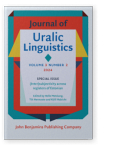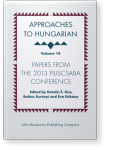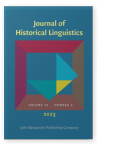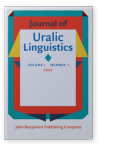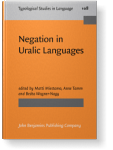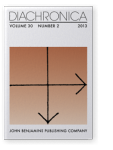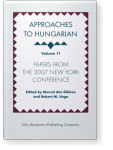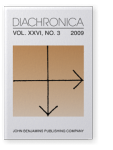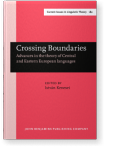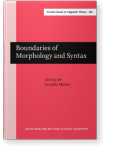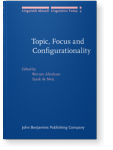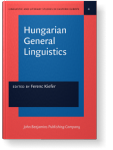Katalin É. Kiss
List of John Benjamins publications for which Katalin É. Kiss plays a role.
Journal
Titles
Approaches to Hungarian: Volume 14: Papers from the 2013 Piliscsaba Conference
Edited by Katalin É. Kiss, Balázs Surányi and Éva Dékány
[Approaches to Hungarian, 14] 2015. v, 296 pp.
Subjects Generative linguistics | Syntax | Theoretical linguistics | Uralic languages
Verb Clusters: A study of Hungarian, German and Dutch
Edited by Katalin É. Kiss and Henk van Riemsdijk
[Linguistik Aktuell/Linguistics Today, 69] 2004. vi, 514 pp.
Subjects Generative linguistics | Germanic linguistics | Syntax | Theoretical linguistics | Uralic languages
2023 The emergence of conjunctions and phrasal coordination in Khanty Journal of Historical Linguistics 13:2, pp. 173–219 | Article
Prior to widespread contact with Russian, Khanty (Uralic; Finno-Ugric) did not have overt conjunctions or phrasal coordination. Instead, Khanty texts from the late 19th–early 20th centuries only include examples of conjunction-less clausal juxtaposition, which was used for both clausal and… read more
2022 The reflexive cycle: From reflexive to personal pronoun in Uralic Journal of Uralic Linguistics 1:1, pp. 43–66 | Article
Starting from a morphosyntactic puzzle of the Ugric and Samoyedic languages of the Uralic family (possessive agreement suffixes functioning as accusative allomorphs on pronominal objects), this paper identifies a pronoun cycle which leads from reflexives via intensifiers and via referentially… read more
2015 Negation in Hungarian Negation in Uralic Languages, Miestamo, Matti, Anne Tamm and Beáta Wagner-Nagy (eds.), pp. 219–238 | Article
The paper presents predicate negation and constituent negation in Hungarian, both of which are expressed by the negative particle nem in indicative clauses, and by ne in imperative, subjunctive, and optative clauses. Se(m) is analyzed as a minimalizing particle, which can replace the particle ne(m)… read more
2013 From Proto-Hungarian SOV to Old Hungarian Top Foc V X Diachronica 30:2, pp. 202–231 | Article
This paper argues that Hungarian underwent a word order change from SOV to Top Foc V X* prior to its documented history beginning in 1192. Proto-Hungarian SOV is reconstructed primarily on the basis of shared constructions of archaic Old Hungarian, and Khanty and Mansi, the sister languages of… read more
2011 On a type of counterfactual construction Approaches to Hungarian: Volume 12: Papers from the 2009 Debrecen Conference, Laczkó, Tibor and Catherine O. Ringen (eds.), pp. 85–108 | Article
This paper analyzes a Hungarian modal construction with a counterfactual, reproaching reading. Hungarian optative, imperative and reproaching sentences involve a MoodP below their topic projection. Their Mood head is merged with a projection having a matching modal feature: a NonNeutP with a… read more
2009 Negative quantifiers in Hungarian Approaches to Hungarian: Volume 11: Papers from the 2007 New York Conference, Dikken, Marcel den and Robert M. Vago (eds.), pp. 65–94 | Article
This paper derives the properties of Hungarian se-pronouns from independently motivated assumptions, among them an adjunction theory of Q-raising allowing both left- and right-adjunction. Se-pronouns are identified as negative polarity quantifiers not conveying any negation, licensed by the… read more
2009 Review of Ferraresi & Goldbach (2008): Principles of Syntactic Reconstruction Diachronica 26:3, pp. 448–455 | Review
2004 Parallel strategies of verbal complex formation in Hungarian and West-Germanic? Verb Clusters: A study of Hungarian, German and Dutch, Kiss, Katalin É. and Henk van Riemsdijk (eds.), pp. 335–358 | Article
2004 Verb clusters: Some basic notions Verb Clusters: A study of Hungarian, German and Dutch, Kiss, Katalin É. and Henk van Riemsdijk (eds.), pp. 1–40 | Article
1999 Strategies of Complex Predicate Formation and the Hungarian Verbal complex Crossing Boundaries: Advances in the theory of Central and Eastern European languages, Kenesei, István (ed.), pp. 91–114 | Article
1999 The English Cleft Construction as a Focus Phrase Boundaries of Morphology and Syntax, Mereu, Lunella (ed.), pp. 217–230 | Article
1986 The Order and Scope of Operators in the Hungarian Sentence Topic, Focus and Configurationality: Papers from the 6th Groningen Grammar Talks, Groningen, 1984, Abraham, Werner and Sjaak de Meij (eds.), pp. 181–214 | Article
1982 Samuel Brassai's theory of the sentence Hungarian General Linguistics, Kiefer, Ferenc † (ed.), pp. 331–349 | Article
